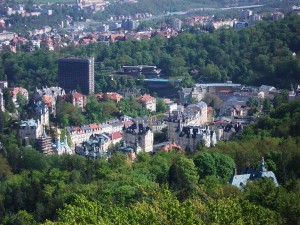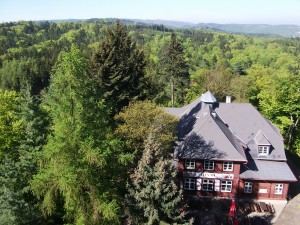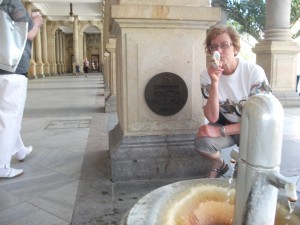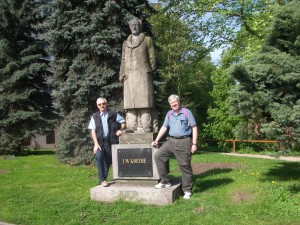Will and I included Karlovy Vary in our Czech Republic itinerary because I have a vague idea for a historical novel partially set in that town. Why Karlovy Vary, a place I had never visited? My maternal grandparents were Czech immigrants and the novel will be my fictionalized story of their immigrant journey.
For years, I had heard of Karlovy Vary as Karlsbad, its German name (Carlsbad in English). From high school history, I recalled the term ‘Carlsbad Agreement’ or ‘Decrees’, although couldn’t remember what the decrees were about. I also knew Karlsbad was a classy spa frequented kings, aristrocrats and artists.
Driving into the town, my first impression was similar to that of Venice or Disneyland: streets of beautiful architecture too harmonious to be real. A closer look revealed anomalies, like the modern Hotel Thermal as well as factories and communist era block apartments outside the lovely spa zone.

European spa towns, like those in North America, develop in areas of natural springs. Both concern healing as well as recreation, but Karlovy Vary’s large spa resorts include hospital-like corridors where attendants dressed in medical scrubs give guests massages, mineral baths and other treatments that sometimes come with a doctor’s referral.
Since walks in the countryside are part of the spa treatment , well-marked trails criss-cross the hills surrounding Karlovy Vary. Our first morning, Will and I rode a funicular to the Diana Tower for spectacular views of the town and trees dressed in fresh, spring green.

We spent three more hours walking trails and wound down to the old town for lunch in an outdoor cafe. Prices are cheaper here than in the spa zone, which is still reasonably priced by our Canadian standards.
People with digestive complaints come to Karlovy Vary to drink the heavily mineralized spring water that ranges in temperature from 45 to 73 degrees Celsius. Shops all over town sell ‘flattened china teapots’ with spouts designed to let you sip without the minerals staining your teeth.

Free springs for sipping are located in colonades through the spa zone. They are so subtle, we unknowing walked right by them on our first evening. The next day, with our spotting map, we found them all and sampled a few. Our guidebook warned us not to drink large amounts to not cause stomach upset. No problem, as the mineral content made the water taste quite foul.
At our hotel breakfast buffet on our last day, we met Sigbert, a German who had come to Karlovy Vary to reconnect with his roots. Sigbert was born in the region and lived there until age thirteen, an unhappy time he had avoided revisting until now. After World War ll, the Czechs expelled their German occupiers and persecuted the German nationals who remained. During the easing of communist travel restrictions in the late 1960s, Sigbert’s family was able to leave the country for a suitable payment. Sigbert ultimately became an engineer for Mercedes Benz in Stuttgart after a brief army assignment of listening in on Czech radio broadcasts from across the iron curtain.

Sigbert had opted to take the train to Karlovy Vary rather than drive because he was travelling alone and because Mercedes aren’t considered safe in Karlovy Vary, which is now largely owned by Russians. Our Czech-made Skoda was probably not at risk for theft. Sigbert recommended we visit a castle in Loket on our route out of Karlovy Vary. He remembered it from a school trip and was going that day, so we offered him a lift. Together, we enjoyed seeing the castle’s great views and torture chambers most little boys would love.
In the castle parking lot, was a statue of the writer Goethe, who had visited Loket during a stay in Karlovy Vary. At age 72, Goethe fell in love with a local seventeen year old woman. For some reason, she rejected his advances. At least he got a poem out of the experience.
